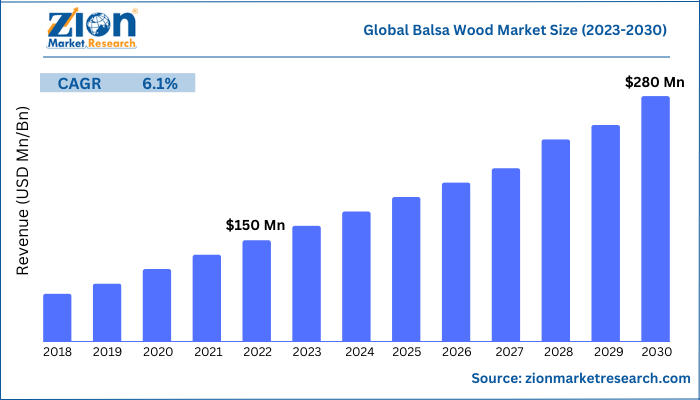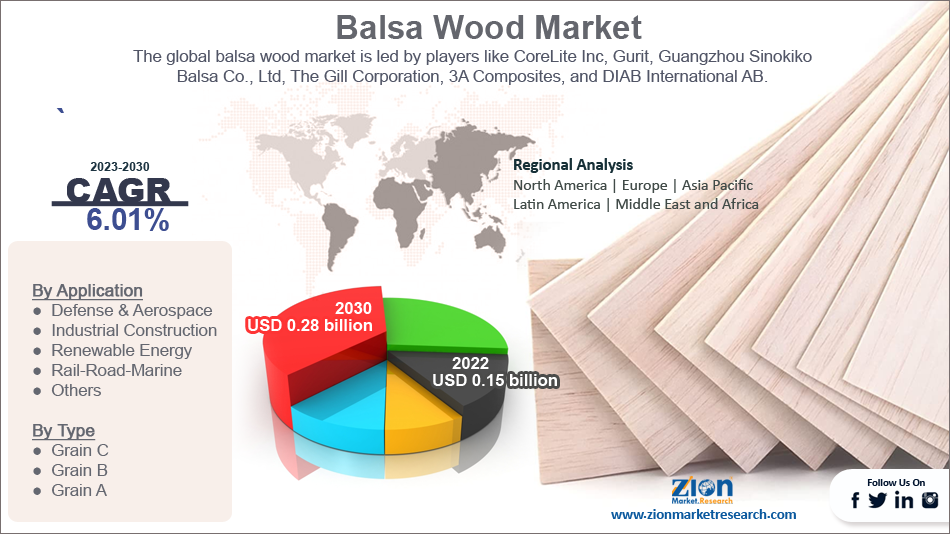Balsa Wood Market Size, Share, Trends, Growth 2030

Balsa Wood Market By Application (Defense & Aerospace, Industrial Construction, Renewable Energy, Rail-Road-Marine, and Others), By Type (Grain C, Grain B, and Grain A), By Region - Global and Regional Industry Overview, Market Intelligence, Comprehensive Analysis, Historical Data, and Forecasts 2022 - 2030
| Market Size in 2022 | Market Forecast in 2026 | CAGR (in %) | Base Year |
|---|---|---|---|
| USD 150 Million | USD 280 Million | 6.01% | 2022 |
Balsa Wood Industry Prospective:
The global balsa wood market size was worth around USD 150 Million in 2022 and is predicted to grow to around USD 280 Million by 2030 with a compound annual growth rate (CAGR) of roughly 6.01% between 2023 and 2030.
The report analyzes the global balsa wood market drivers, restraints/challenges, and the effect they have on the demands during the projection period. In addition, the report explores emerging opportunities in the balsa wood market.
Balsa Wood Market: Overview
Ochroma pyramidale is the scientific name for a balsa tree. It is a fast-growing, large tree that has origins in America. Currently, the balsa tree is the sole identified member of the Ochroma genus. The wood that originates from the balsa tree has extensive applications in the woodworking industry and the word ‘balsa’ represents ‘raft’ in Spanish. Ochroma pyramidale is a deciduous angiosperm that stands for flowering plants that have the capacity of bearing fruits and flowers. They can also form angiosperms. Furthermore, the tree can grow up to 30 meters in height and even though the wood from the tree is soft, it is classified as hardwood. In the commercial world, it is the softest hardwood available for various applications and in reality, the lightweight nature of the wood makes it highly desirable.
Key Insights
- As per the analysis shared by our research analyst, the global balsa wood market is estimated to grow annually at a CAGR of around 6.12% over the forecast period (2022-2030)
- In terms of revenue, the global balsa wood testing market size was valued at around USD 0.15 billion in 2022 and is projected to reach USD 0.28 billion, by 2030.
- The balsa wood market is projected to grow at a significant rate due to the growing demand for lightweight structures across the building and construction industry
- Based on type segmentation, Grain B was predicted to show maximum market share in the year 2022
- Based on application segmentation, defense & aerospace was the leading application in 2022
- On the basis of region, North America was the leading revenue generator in 2022
Balsa Wood Market: Growth Drivers
Growing demand for lightweight structures to act as a major expansion driver
The global balsa wood market is projected to grow owing to the increasing demand for lightweight structures across small to large-scale building and construction activities. Balsa wood is one of the most lightweight woods available for commercial purposes and it acts as a major attractive point for the trees and its wood. It has applications in building structures across sizes. For instance, the composite segment in the building industry is one of the largest consumers of balsa wood.
They are used extensively for the construction of wind turbine blades along with other materials to give the necessary structure to the units. Furthermore, table tennis bats are another prime example of balsa wood applications, where they are generally placed in between two separate pieces of extremely thin plywood that have origins from other wood species. Glass-reinforced plastic, also known as fiberglass, also utilizes balsa wood for its structural construction. The topsides and docks for various types of boats along with excellent quality surfboards are made of balsa wood.
Balsa Wood Market: Restraints
Low compressive strength to act as a growth restraint
Balsa wood is generally low in compressive strength and lacks the bending capabilities exhibited by different other species of wood. Since it lacks the necessary strength, balsa wood cannot be used to manufacture furniture. The balsa wood industry is an important contributor to the wood sector and ones extracted from balsa trees cannot be used. The low strength attribute of balsa wood also causes it to be the least preferred choice in work involving large woodworking activities or flooring projects. Furthermore, balsa wood is flammable thus posing a hazard under certain circumstances.
Balsa Wood Market: Opportunities
Growing need for composite materials to provide growth opportunities
Although balsa wood may not necessarily be used as a standalone product in certain situations, it is highly in demand for manufacturing composite materials. This allows makers to manage the disadvantages or drawbacks of balsa wood while imparting or reinforcing it with additional qualities. This aspect improves the overall workability and desirability of the wood. Additionally, the high sustainability value offered by balsa wood is causing multiple businesses to opt for measures that can help them best utilize the benefits of balsa wood while ensuring that the drawbacks are taken care of.
Balsa Wood Market: Challenges
Substitute availability to challenge the market expansion
One of the key challenges faced by suppliers of balsa wood is the high availability of substitutes that offer a better performance index and cost-effectiveness. Furthermore, the wood is extremely soft and it can break easily as compared to the substitutes. This means that makers have to be extremely careful while handling the wood since any negligence can cause a loss of product thus impacting the profit volume.
Balsa Wood Market: Segmentation
The global balsa wood market is segmented based on application, type, and region
Based on application, the global market divisions are defense & aerospace, industrial construction, renewable energy, rail-road-marine, and others
- In 2022, the global market registered the highest growth in the defense & aerospace segment and it may generate a revenue of 0.07 billion by the end of 2023
- The primary reason that propels the demand for balsa wood in the segment is the lightweight nature of the wood making it an ideal choice to manufacture different parts of airplanes and other units used in the industry
- Since the structure is similar to the core of the honeycomb and has commercial availability across thickness, finish, and density, the wood is high in demand
Based on type, the balsa wood industry is segmented into grain C, grain B, and grain A
- In 2022, the highest sales were registered in the grain B segment since it has the widest end-user applications
- In the same year, the segment gained a market share of almost 41.1%
- Grain B, on multiple occasions, has been classified as an all-purpose wood which is a primary reason for the high demand for the grain structure
Recent Developments:
- In December 2020, CoreLite, a leading manufacturer of advanced versions of balsa wood, signed an agreement with the Los Rios Province, Ecuador government. The agreement will support CoreLite in the long-term plantation of balsa wood. The move will allow the company to plant and harvest balsa wood throughout the province for the next 5 years
- In April 2022, INCA BioBalsa announced that it will build a new and advanced facility in Alberta, Canada. The unit will be used for the production of high-grade biocomposites that will act as a substitute for the growing scarcity of balsa for the production of wind turbine blades, boats, automotive, and rail
- In September 2022, Tornado Updraft launched a new version of balsa-wood planes that now come with an electric makeover. The toy planes are available at USD 105 per piece and are remote-controlled and allow the user to assemble the plane on their own
Balsa Wood Market Report Scope:
| Report Attributes | Report Details |
|---|---|
| Report Name | Balsa Wood Market Research Report |
| Market Size in 2022 | USD 150 Million |
| Market Forecast in 2030 | USD 280 Million |
| Compound Annual Growth Rate | CAGR of 6.01% |
| Number of Pages | 182 |
| Key Companies Covered | CoreLite Inc, Gurit, Guangzhou Sinokiko Balsa Co., ltdLtd, The Gill Corporation, 3A Composites, and DIAB International AB. |
| Segments Covered | By Application, By Type, And By Region |
| Regions Covered | North America, Europe, Asia Pacific (APAC), Latin America, Middle East, and Africa (MEA) |
| Base Year | 2022 |
| Historical Year | 2017 to 2021 |
| Forecast Year | 2023 - 2030 |
| Customization Scope | Avail customized purchase options to meet your exact research needs. Request For Customization |
Balsa Wood Market: Regional Analysis
Asia-Pacific to register the highest growth during the forecast period
The global balsa wood market is expected to register the highest growth in Asia-Pacific during the projection period since countries like India, Singapore, and China are the largest importers of balsa wood. The region is expected to continue its dominance as the infrastructure sector in these countries is expected to reach new heights in the coming years. Furthermore, China has been investing heavily in the in-house production of balsa wood to manage the shortage of raw materials induced due to various political factors.
The country is one of the largest investors in wind turbines in the last few years and has shown tremendous applications for balsa wood. However, it is also facing issues in terms of continuous supply from other countries and hence plans to invest in harvesting the trees within the country. North America is expected to register a high CAGR influenced by the wide applications of balsa wood across the building and construction industry.
Balsa Wood Market: Competitive Analysis
The global balsa wood market is led by players like:
- CoreLite Inc
- Gurit
- Guangzhou Sinokiko Balsa Co. Ltd
- The Gill Corporation
- 3A Composites
- DIAB International AB.
The global balsa wood market is segmented as follows:
By Application
- Defense & Aerospace
- Industrial Construction
- Renewable Energy
- Rail-Road-Marine
- Others
By Type
- Grain C
- Grain B
- Grain A
By Region
- North America
- The U.S.
- Canada
- Europe
- France
- The UK
- Spain
- Germany
- Italy
- Rest of Europe
- Asia Pacific
- China
- Japan
- India
- South Korea
- Southeast Asia
- Rest of Asia Pacific
- Latin America
- Brazil
- Mexico
- Rest of Latin America
- Middle East & Africa
- GCC
- South Africa
- Rest of Middle East & Africa
Table Of Content
Methodology
FrequentlyAsked Questions
Ochroma pyramidale is the scientific name for a balsa tree. It is a fast-growing, large tree that has origins in America. Currently, the balsa tree is the sole identified member of the Ochroma genus.
The global balsa wood market is projected to grow owing to the increasing demand for lightweight structures across small to large-scale building and construction activities.
According to study, the global balsa wood market size was worth around USD 0.15 billion in 2022 and is predicted to grow to around USD 0.28 billion by 2030.
The CAGR value of the balsa wood market is expected to be around 6.01% during 2022-2030.
The global balsa wood market is expected to register the highest growth in Asia-Pacific during the projection period since countries like India, Singapore, and China are the largest importers of balsa wood.
The global balsa wood market is led by players like CoreLite Inc, Gurit, Guangzhou Sinokiko Balsa Co., ltdLtd, The Gill Corporation, 3A Composites, and DIAB International AB.
RelatedNews
HappyClients
Zion Market Research
Tel: +1 (302) 444-0166
USA/Canada Toll Free No.+1 (855) 465-4651
3rd Floor,
Mrunal Paradise, Opp Maharaja Hotel,
Pimple Gurav, Pune 411061,
Maharashtra, India
Phone No +91 7768 006 007, +91 7768 006 008
US OFFICE NO +1 (302) 444-0166
US/CAN TOLL FREE +1 (855) 465-4651
Email: sales@zionmarketresearch.com
We have secured system to process your transaction.
Our support available to help you 24 hours a day, five days a week.
Monday - Friday: 9AM - 6PM
Saturday - Sunday: Closed







